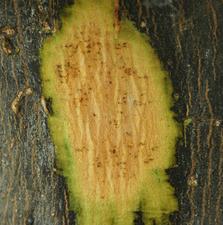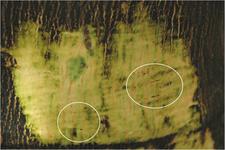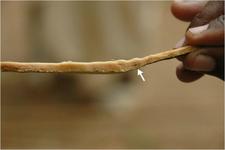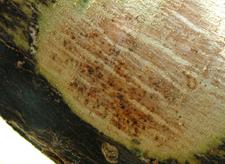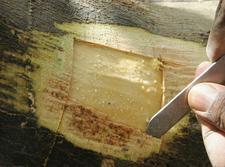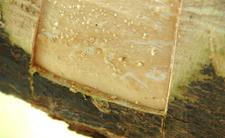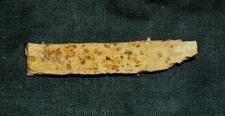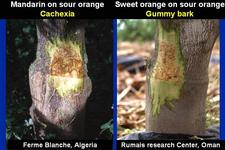Kassala Disease
HISTORY, DISTRIBUTION AND IMPORTANCE
Seen for the first time in 1987 in Kassala (Eastern Sudan) and described by Bové (Bové, 1995). The symptoms of affected grapefruit trees are gum impregnations in the bark and mild stem pitting that resemble those of cachexia in mandarin and gummy bark in sweet orange. Symptoms of Kassala disease have also been seen in southern Yemen.
NAME OF DISEASE AND SYNONYMS
Kassala disease (Bové, 1995)
Abbreviation: KD for Kassala disease.
SYMPTOMATOLOGY
General aspect of affected field tree
Not reported.
Symptoms on trunk (on rootstock and/or scion), limbs and shoots
Scraping the trunk to remove the outer layers of bark, shows the whitish bark tissues to be impregnated with streaks of reddish-brown gum-like material (KD. 01, 02), particularly near the bud union. Bark discoloration affects only the grapefruit scion. Removal of a piece of bark across the bud union is required to see pitting of the grapefruit xylem. After bark removal, the stem pitting observed on affected trees (KD. 03) resembles those of cachexia on cachexia-sensitive hosts and those of gummy bark on sweet orange and rough lemon. However, the amount of gum in the bark seems to be smaller than that seen in the case of cachexia and gummy bark, even though bark gumming can extend up to 2 m above the bud-union.
Symptoms on leaves
No specific symptoms.
Symptoms on fruit
None.
Histological and cytological symptoms
None described.
CAUSAL AGENT: DESCRIPTION AND PROPERTIES
The graft-transmissibility of the agent has not been studied. The nature of the agent is unknown.
HOST RANGE
Thus far, restricted to Citrus spp.; non-rutaceous hosts: unknown.
Sensitive species, varieties or combinations
The disease was seen on the scions of Foster and Marsh seedless grapefruit trees grafted on sour orange.
Symptomless species, varieties or combinations
· Immune: none described
· Tolerant (symptomless carrier): Sour orange.
TRANSMISSION
Natural
Cultural transmission through budwood is probable, but not demonstrated.
No evidence for vector transmission.
Experimental
Graft transmission has not been demonstrated.
Mechanical transmission: not reported.
EPIDEMIOLOGY
Not studied.
DIAGNOSIS
Diagnostic field symptoms
Scraping the bark of the grapefruit trunk above the bud union reveals gum deposits (KD. 04). Bark removal across the bud-union shows stem pitting on the grapefruit scion (KD. 05, 06, 07).
Comparison with other diseases
After bark removal, affected trees show stem-pitting symptoms resembling those of cachexia on cachexia-sensitive hosts and those of gummy bark on sweet orange (KD. 08).
Biological indexing
Not available
Serological and molecular diagnostic methods
None available.
CONTROL
Use of kassala disease–free budwood.
SELECTED REFERENCES
Bové, J.M. (1995). Virus and virus-like diseases of citrus in the Near East region. Chapter 20, The Sudan. FAO, Rome, p 303-318.
Prepared (2008) by N. Duran-Vila1 and J.M. Bové2
1Centro de Protección Vegetal y Biotecnología
Instituto Valenciano de Investigaciones Agrarias
Apartado oficial 46113 MONCADA (Valencia)
(Spain)
2IBVM, Laboratoire de Biologie Cellulaire and Moleculaire,
I.N.R.A./ Université de Bordeaux 2,
Centre INRA de Bordeaux,
71, Ave. E. Bourleau,
33883 – Villenave d’Ornon,
(France)
Click on any image to see it larger.
PHOTOS |
LEGENDS AND AUTHORS |
|---|---|
|
Trunk of a Foster grapefruit grafted on sour orange affected by severe Kassala disease. Scraping away outer layers of bark reveals the presence of gum-like streaks. (South Sawagi, Sudan) – N. Duran-Vila
|
|
|
Trunk of a grapefruit grafted on sour orange mildly affected by Kassala disease. Scraping away outer layers of bark reveals the presence of gum-like streaks. (Government nursery, Kitiab, Sudan) – N. Duran-Vila
|
|
|
Strip of bark removed from the tree of KD. 02. Note the presence of gum deposits. (Government nursery, Kitiab, Sudan) – N. Duran-Vila
|
|
|
Trunk of a Foster grapefruit grafted on sour orange affected by severe Kassala disease. Scraping away outer layers of bark reveals the presence of gum-like deposits. (South Sawagi, Sudan) – N. Duran-Vila
|
|
|
Same as KD. 04. Photo was taken while a patch of bark was being removed. (South Sawagi, Sudan) – N. Duran-Vila
|
|
|
Same as KD. 04 and KD. 05. Note: (i) aspect of wood and (ii) gum impregnations in the bark. (South Sawagi, Sudan) – N. Duran-Vila
|
|
|
Outer face of a strip of the bark removed from a severely affected grapefruit tree after bark had been scraped. (South Sawagi, Sudan) – N. Duran-Vila
|
|
|
Symptoms of cachexia on mandarin grafted on sour orange (Ferme Blanche, Algeria) and symptoms of gummy bark on sweet orange grafted on sour orange (Rumais Research Center, Sultanate of Oman) – J.M. Bové |

